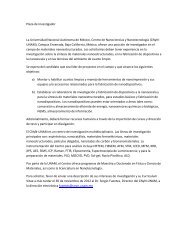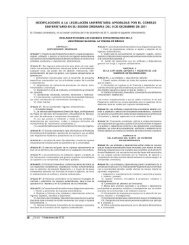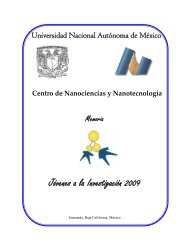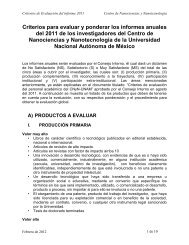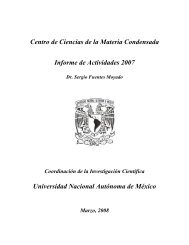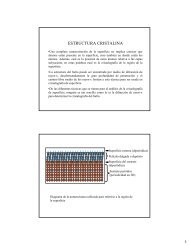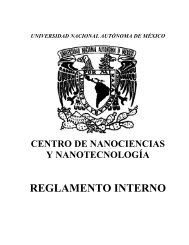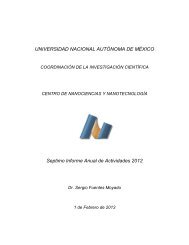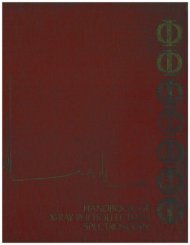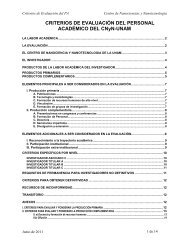Universidad Nacional Autónoma de México - CNyN
Universidad Nacional Autónoma de México - CNyN
Universidad Nacional Autónoma de México - CNyN
Create successful ePaper yourself
Turn your PDF publications into a flip-book with our unique Google optimized e-Paper software.
1st International Symposium on Nanoscience and Nanomaterials<br />
usually different from their single metal counterparts and they significantly vary as a function of composition<br />
and particle size. The enhanced properties of bimetallic metal catalysts are generally attributed to either<br />
ensemble or ligand effects although other factors related to particle size effects and matrix effects, have been<br />
invoked. Some examples about the preparation of Au-Ag catalysts supported on TiO, by a new method based<br />
on <strong>de</strong>position-precipitation, their characterization and catalytic activity in the reaction of CO oxidation will be<br />
shown [1]. Another way to overcome the <strong>de</strong>activation process is to produce oxygen vacancies on the surface<br />
of the support particles. These oxygen vacancies generate crystalline <strong>de</strong>fects that work as pinning centers for<br />
the gold particles. The steps on the surface of the support particles are also crystalline <strong>de</strong>fects that could work<br />
as pinning centers for the gold particles. Theoretical calculations have <strong>de</strong>monstrated that the gold particles<br />
bind stronger to a <strong>de</strong>fect-rich surface than to a <strong>de</strong>fect-<strong>de</strong>ficient surface and that a significant charge transfer<br />
occurs from the titania support to the Au particles, which could explain the catalytic activity of the Au<br />
particles for the oxidation of CO. To illustrate this kind of systems, the characterization, catalytic performance<br />
and stability in the CO oxidation reaction of Au/TiO 2 and Au/Y-TiO 2 will be discussed [2]. The Y-TiO 2<br />
supports were prepared by the sol-gel method and the Au supported nanoparticles were obtained from the<br />
DP–Urea process.<br />
[1] A. Sandoval, A. Aguilar, C. Louis, A. Traverse, R. Zanella, J. Catal. 281 (2011) 40-49.<br />
[2] R. Zanella, V. Rodríguez-González, Y. Arzola, A. Moreno-Rodríguez, ACS Catalysis 2 (2012) 1-11.<br />
PLENARY X<br />
FUNDAMENTAL PROPERTIES OF TM NITRIDES: DESIGN STRATEGIES FOR GROWTH OF<br />
SELF-ORGANIZED NITRIDE NANOSTRUCTURES<br />
Joseph E. Greene<br />
Departments of Materials Science, Physics, and the Materials Research Laboratory<br />
University of Illinois, Urbana, Illinois, USA<br />
Physics Department, Linköping University, Linköping, Swe<strong>de</strong>n<br />
Mat. Sci. Dept, National Taiwan University of Science & Technology, Taipei, Taiwan<br />
Cubic TM nitri<strong>de</strong>s have wi<strong>de</strong> single phase compound fields which can be exploited. We show results<br />
for vacancy har<strong>de</strong>ning (not associated with film strain) in 3d group-IV TiN x (001): the hardness H of epitaxial<br />
layers increases dramatically, while the elastic modulus E and the relaxed lattice constant <strong>de</strong>crease linearly, as<br />
x is <strong>de</strong>creased from 1.0 to 0.67. Over the same x range, the resistivity (x) increases from 13 to 192 -cm<br />
due to electron scattering from N vacancies. In contrast, H(x), E(x), and (x) for 5d group-V TaN x (001)<br />
remain constant due primarily to the presence of isoelectronic antisites. While TiN and TaN are metallic, 3d<br />
group-III ScN(001) is a transparent semiconductor with an indirect Γ-X gap of 1.3 eV and a direct X-point<br />
gap of 2.4 eV. Reflectivity measurements from Sc 1-x Ti x N(001) layers show TiN is strongly reflecting up to the<br />
reflectance edge at ћ e = 2.3 eV, ScN is transparent, and e x 0.5 . Thus, hard <strong>de</strong>corative coatings with a wi<strong>de</strong><br />
palette of colors can be obtained. The extreme range of materials properties available in TM nitri<strong>de</strong>s and<br />
related systems can be enhanced through the formation of self-organized superhard nanostructures consisting<br />
of commensurate nanolamellae, nanocolumns, nanospheres, and nanopipes. Self-organization strategies<br />
inclu<strong>de</strong> controlled phase separation, surface-induced spinodal <strong>de</strong>composition, surface segregation-induced<br />
renucleation, strain-induced roughening, surface anisotropy, and dynamic resputter yield amplification. As a<br />
6




